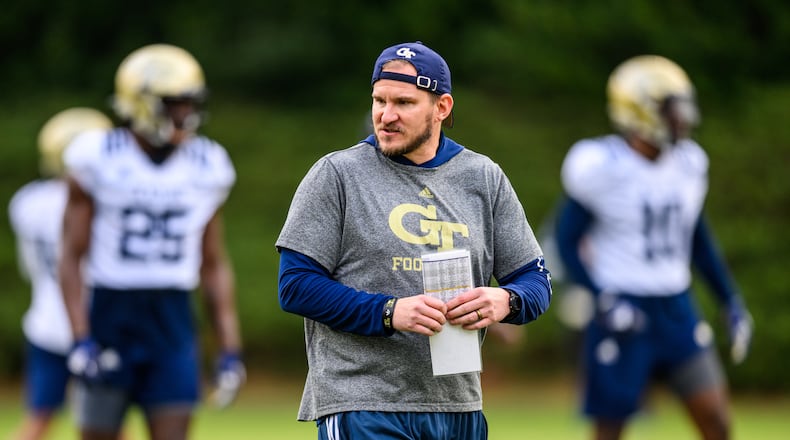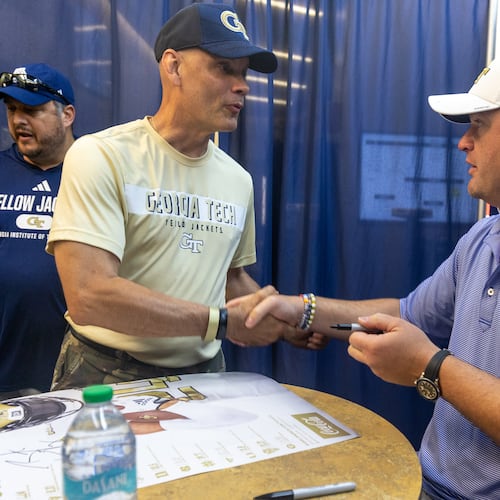Brent Key had just been named Georgia Tech’s interim coach, and he was a man looking for solutions. To that end, he sat down with linebackers coach Jason Semore to understand how the team could stop getting its punts blocked.
“Coach Key kind of asked me, ‘What do you see the issues are, how do you get this fixed?’” Semore said in an interview with The Atlanta Journal-Constitution. “‘If you were to fix it, what would you do?’”
It was a question that Semore had been asking himself since the season opener, when Clemson blocked two punts en route to its 41-10 win at Mercedes-Benz Stadium. On his own, he had been researching different teams’ punt-protection schemes, calling colleagues and putting together a video package of about 160 punt plays.
It wasn’t about determining the best punt scheme. He was looking for an effective but uncomplicated protection that could be taught quickly, that would be comfortable for punter David Shanahan to work with and that, if a player made a mistake, could still give Shanahan a chance to get the punt off. He considered how the scheme could be best taught in a week’s time, day by day.
Semore mulled over the questions, making use of the sleepless nights he endured as the Yellow Jackets stumbled out of the gate and ultimately had four punts blocked in their first four games. The lapses symbolized coach Geoff Collins’ tenure, contributing to losses that cost him his job and put Key in his seat. Semore’s research led him to an alignment that lined up seven players on the line, with three sturdy linemen forming a shield in front of Shanahan.
“It was one of those things where I was like, ‘What can I do about this? How can I prepare? How can I help?’” Semore said. “I just want to see those guys have success.”
As Semore presented his suggestions to Key, he said he felt the scope of the meeting changing.
“Halfway through the conversation, I was like, ‘Am I being interviewed or something?’” Semore said with a laugh. “So after I got done talking, he was like, ‘Well, would you be interested in being special-teams coordinator?’ So that’s kind of how it went down.”
Key’s term as interim coach is but one game old. He’ll lead the Jackets against Duke on Saturday at Bobby Dodd Stadium in his second game as the temporary head of his alma mater’s team. But the outcome of that one game, the Jackets’ 26-21 road upset of then-No. 24 Pittsburgh, and notably the lack of blocked punts allowed in the face of an aggressive punt-block attack by Pitt, validated one of Key’s initial decisions as interim, to put Semore in charge of special teams.
For Semore, it was a highlight in a career that has been a slow climb up the coaching ladder since he graduated from Division II Adams State (where he played linebacker) in 2005. The journey has included four stops at Division II schools, including last year at Valdosta State, but has earned the respect of those he has coached alongside.
Said Kansas State cornerbacks coach Van Malone, a mentor of Semore’s, “He is the essence of what coaching is.”
Semore, who grew up in Ganado, Ariz., was drawn to coaching through his father, Russ, who was a high-school coach.
“I never really had a choice,” Semore said.
He was answering a call for developing players and helping them reach their potential.
“And how you do that is you educate your players on, ‘Listen, this is the process for having success,’ and it’s about educating them about the habits that are needed, being honest with them in the criticism aspect of it,” Semore said.
Semore, married with three children, keeps journals to help him progress. He keeps one journal for X’s and O’s and another for player development and culture. He updates them daily and has filled about 12 over the course of his career.
“When I was growing up, my dad, he taught me that you’re ultimately going to be a product of two things,” Semore said. “Your choices and the habits that you have. So what is your daily plan and the habits that you have daily to ultimately reach your goal?”
So it was that he began his punt-protection research project well before anyone asked him to take it on. He gave himself the task, imagining himself as the head coach and trying to solve the problem if he were in that position.
“It really goes back to, you never know when opportunities are going to come,” he said. “And I’ve found out, the longer I’ve been in this business and the longer I’m alive, if you prepare for them when they come, you oftentimes are going to have a chance to have success.”
When he was in a support-staff role as a defensive assistant at Oklahoma State from 2012-13, coach Mike Gundy hosted a clinic for coaches. One of the visitors was Bob Stitt, who had had Semore on his staff at Division II Colorado School of Mines in 2007. Stitt is an offensive-minded coach. He is credited as the originator of the fly-sweep play in which the quarterback takes the shotgun snap and tosses the ball forward to a receiver as he sprints past along the line. But he wanted to learn defense, so he huddled with Semore.
“A lot of times, you can go in and talk to a graduate assistant about things, and they know kind of the Reader’s Digest version of it,” Stitt said. “And he really understood everything about the defense and how it worked. And I was like, ‘Man, this guy’s a young guy, but he’s ready to do this.’”
When Stitt was hired as head coach at FCS Montana in December 2014, he hired Semore first as safeties coach and special-teams coordinator and then moved him up to defensive coordinator.
“He really relates well to the players, and he just has a way of getting the most out of them,” Stitt said. “They really, really play hard for him.”
It also was at Oklahoma State where Gundy gave him his nickname, Boogie. It had nothing to do with Semore; it was the nickname of an assistant who had just left the team.
“It was probably because he didn’t remember my name,” Semore said. “It was right when I got hired, and then everybody started calling me that.”
His job at Oklahoma State also connected him with Andrew Thacker, then a GA. Thacker helped bring him to Temple in 2018 as a defensive analyst, and Collins brought him to Tech for a similar position that he held before taking a defensive coordinator job at Division II Valdosta State. But back to the nickname.
Said Malone, the Kansas State assistant coach who brought him to Oklahoma State from Tulsa, “I do remember Jason always being like, ‘Damn, he doesn’t know my name’ when he first got there.”
Semore has gone by “Boogie” ever since. It probably says something about him that he was willing to embrace a nickname that wasn’t even his to begin with and given to him because it was convenient.
The origin story likely wouldn’t surprise Gary Goff, who was coach at Valdosta State last year when he hired Semore from Tech (where he was defensive analyst) to be his defensive coordinator. The Blazers reached the Division II title game, earning Goff the head job at FCS McNeese State and helped bring Semore back to Tech, this time as linebackers coach.
“Here’s what I love about Semore,” Goff said. “He’s a great person, but he’s in this profession for the right reason, and that’s to change lives through the sport. He doesn’t have an ego. It’s always the players and the team first, and I really appreciate that.”
His coaching acumen, his readiness and selflessness made him Key’s only choice to be his new special-teams coordinator.
“He’s a ball coach,” Key said. “And I can’t give him any higher compliment than that.”
Relying on help from fellow assistant coaches, Semore taught the new punt-protection scheme on the fly, switching out seven players from the former punting unit. Semore recognized that it was a highly inopportune time to change scheme, given Pitt’s aggressive approach.
“I went into the game feeling game ready, but I would be lying if I sat here and told you that I wasn’t drinking Pepto Bismol in the (coaching) box because I had an ulcer,” Semore said, laughing. “And the guys, they executed above and beyond.”
Semore also was in on the decision that promoted kicker Gavin Stewart, who responded by making all four of his field-goal tries against Pitt after Jude Kelley had struggled in Tech’s first four games.
“A thing coach Key always says (is), we’re crazy if we keep doing the same things and expect different results,” Semore said. “It was just one of those things where we all felt comfortable with making that move at that point in time just to see. Let’s give some opportunities to some different guys.”
One of those different guys was a ball coach named Jason Semore, who has made good on his chance.
About the Author
Keep Reading
The Latest
Featured



